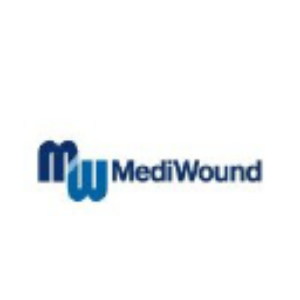MediWound Announces Positive Results from its U.S. Phase 2 Pharmacology Study of EscharEx for Debridement of Lower Leg Ulcers
Rhea-AI Summary
MediWound Ltd. (Nasdaq: MDWD) announced positive results from a Phase 2 study of EscharEx, a biotherapeutic solution for debridement in venous leg ulcers (VLUs) and diabetic foot ulcers (DFUs). The study found that 70% of patients achieved complete debridement within up to 8 applications, with an average of 3.9 applications required. A significant reduction of 35% in wound size and effective biofilm disruption were noted. EscharEx was well-tolerated with ongoing biomarker analysis, underscoring its potential as a non-surgical treatment option.
Positive
- 70% of patients achieved complete debridement with EscharEx.
- Average of 3.9 applications needed for complete debridement.
- 35% average reduction in wound size after 2-week follow-up.
- Significant reduction in bacterial burden and biofilm presence.
Negative
- None.
News Market Reaction 1 Alert
On the day this news was published, MDWD declined 4.42%, reflecting a moderate negative market reaction.
Data tracked by StockTitan Argus on the day of publication.
EscharEx Showed Safe, Effective and Rapid Debridement in VLUs and DFUs
Data Demonstrates EscharEx Reduced Wound Size, Biofilm and Bacterial Burden
YAVNE, Israel, July 07, 2022 (GLOBE NEWSWIRE) -- MediWound Ltd. (Nasdaq: MDWD) (the “Company”), a fully-integrated biopharmaceutical company focused on next-generation biotherapeutic solutions for tissue repair and regeneration, today announced positive results from its U.S. prospective, open-label, single-arm, Phase 2 pharmacology clinical study of EscharEx® for the debridement of lower leg ulcers.
The study was designed to evaluate the clinical performance, safety and pharmacology effect of EscharEx in debridement of venous leg ulcers (VLUs) and diabetic foot ulcers (DFUs). Seventy percent of patients achieved complete debridement during the course of treatment within up to 8 applications. On average, complete debridement was achieved after 3.9 applications of EscharEx. Additionally, an average reduction of
“The data from our pharmacology study corroborates the results of our previous Phase 2 studies, and clearly supports EscharEx as a potential rapid and effective, non-surgical debriding agent,” said Ofer Gonen, Chief Executive Officer of MediWound. “We are encouraged by the accumulated clinical data and believe that EscharEx, with its attractive product profile, has the potential to become a best-in-class non-surgical debridement option for the millions of patients suffering from chronic wounds.”
Dr. Robert Snyder, Chief Medical Director of EscharEx program added, “We are excited to see the data showing that EscharEx could effectively debride wounds while disrupting biofilm and lowering bacterial load. There is wide consensus among clinicians that infection and microbial biofilm impedes the healing process and prolongs wound healing. We thank our partners, investigative staff, and especially the patients and their families for their commitment in completing the study.”
Study Design
The U.S. phase 2 pharmacology study was a prospective, open label, single-arm study, being conducted at three U.S. clinical sites. The study evaluated the clinical performance, safety, and pharmacology effect of EscharEx in the debridement of lower leg ulcers (VLUs and DFUs). The study evaluated the safety and efficacy of debridement as measured by incidence of, and time to complete debridement. In addition, the study evaluated the pharmacological effects of EscharEx as measured by the changes from baseline to end of treatment period in (1) wound biofilm presence in wound biopsies, (2) bacterial burden measured by MolecuLight® fluorescence images, and (3) biomarkers of wound healing and inflammation in wound fluid.
Twelve patients with either DFUs or VLUs were enrolled in the study. Patients were treated with up to eight daily applications of EscharEx and then continued follow-up for 2 weeks. Punch biopsies and wound fluids were collected prior to the first, and after the last treatment. Biofilm presence was analyzed from wound biopsies. Wound fluids were analyzed to evaluate biomarkers of wound healing and inflammation, i.e., MMPs, cytokines, chemokines, growth factors and HNE. Fluorescent imaging was used during treatment to measure wound size and bacterial load. Fluorescent imaging was also utilized to identify the highest fluorescence area to obtain the biopsy. EscharEx demonstrated safe and effective debridement with a few daily applications. In addition, evaluation of wounds’ tissue samples (biopsies) and fluorescence images, indicated reduction of wound area, biofilm and bacterial bioburden following the treatment with EscharEx.
About Biofilm1
Biofilm is created through the attachment of bacteria to elements in the extracellular polymeric substances (EPS). The EPS, which is
Bacterial biofilm has been shown to prolong the inflammatory process, which is detrimental to wound healing because of the degradation of the growth factors required for cellular proliferation and migration necessary for wound healing.
About EscharEx
EscharEx is a bioactive therapy for debridement of chronic and other hard-to-heal wounds in advanced stages of clinical development. Designed for the outpatient setting, EscharEx is an easy-to-use concentrate of proteolytic enzymes enriched in bromelain for topical daily applications.
EscharEx was well-tolerated and demonstrated safety and efficacy in the debridement of various chronic and other hard-to-heal wounds with only few daily applications in several Phase 2 trials. EscharEx’s mechanism of action is mediated by the proteolytic enzymes that cleave and remove the necrotic tissue and prepare the wound bed for healing.
About MediWound Ltd.
MediWound is a biopharmaceutical company that develops, manufactures, and commercializes novel, cost effective, bio-therapeutic solutions for tissue repair and regeneration. Our strategy leverages our enzymatic technology platform, focused on next-generation bioactive therapies for burn care, wound care and tissue repair.
NexoBrid, our commercial orphan biological product for non-surgical eschar removal of deep-partial and full-thickness thermal burns, is a bromelain-based biological product containing a sterile mixture of proteolytic enzymes that selectively removes burn eschar within four hours without harming surrounding viable tissue. NexoBrid is currently marketed in the European Union and other international markets and is at registration-stage with the Food and Drug Administration (FDA). NexoBrid is supported by the U.S. Biomedical Advanced Research and Development Authority (BARDA).
EscharEx, our next-generation bioactive topical therapeutic under development in the U.S. for debridement of chronic and hard to heal wounds. EscharEx was well-tolerated and has demonstrated safety and efficacy in the debridement of various chronic and other hard-to-heal wounds, within a few daily applications in several Phase 2 trials. An end-of-phase 2 meeting with the FDA is targeted for the second half of 2022.
MW005, our topical biological drug for the treatment of non-melanoma skin cancers, is a clinical-stage product candidate under development.
Committed to innovation, we are dedicated to improving quality of care and patient lives. For more information, please visit www.mediwound.com.
Cautionary Note Regarding Forward-Looking Statements
MediWound cautions you that all statements other than statements of historical fact included in this press release that address activities, events, or developments that we expect, believe, or anticipate will or may occur in the future are forward-looking statements. Although we believe that we have a reasonable basis for the forward-looking statements contained herein, they are based on current expectations about future events affecting us and are subject to risks, assumptions, uncertainties, and factors, all of which are difficult to predict and many of which are beyond our control. Actual results may differ materially from those expressed or implied by the forward-looking statements in this press release. These statements are often, but are not always, made through the use of words or phrases such as “anticipates,” “intends,” “estimates,” “plans,” “expects,” “continues,” “believe,” “guidance,” “outlook,” “target,” “future,” “potential,” “goals” and similar words or phrases, or future or conditional verbs such as “will,” “would,” “should,” “could,” “may,” or similar expressions.
Specifically, this press release contains forward-looking statements concerning the anticipated progress, development, study design, expected data timing, objectives anticipated timelines, expectations and commercial potential of our products and product candidates, including MW005. Among the factors that may cause results to be materially different from those stated herein are the inherent uncertainties associated with the uncertain, lengthy and expensive nature of the product development process; the timing and conduct of our studies of our products and product candidates, including the timing, progress and results of current and future clinical studies, and our research and development programs; the approval of regulatory submission by the European Medicines Agency or by any other regulatory authority, our ability to obtain marketing approval of our products and product candidates in the U.S. or other markets; the clinical utility, potential advantages and timing or likelihood of regulatory filings and approvals of our products and products; our expectations regarding future growth, including our ability to develop new products; risks related to our contracts with BARDA; market acceptance of our products and product candidates; our ability to maintain adequate protection of our intellectual property; competition risks; the need for additional financing; the impact of government laws and regulations and the impact of the COVID-19 pandemic. For example, we are unable to predict how the pandemic will affect the overall healthcare infrastructure, including the ability to recruit patients, the ability to conduct the studies in medical sites and the pace with which governmental agencies, such as the FDA, will review and approve regulatory submissions. Additional government-imposed quarantines and requirements to “shelter at home” or other incremental mitigation efforts also may impact our ability to source supplies for our operations or our ability or capacity to manufacture, sell and support the use of our products and product candidates in the future.
These and other significant factors are discussed in greater detail in MediWound’s annual report on Form 20-F for the year ended December 31, 2021, filed with the Securities and Exchange Commission (“SEC”) on March 17, 2022, Quarterly Reports on Form 6-K and other filings with the SEC from time-to-time. These forward-looking statements reflect MediWound’s current views as of the date hereof and MediWound undertakes, and specifically disclaims, any obligation to update any of these forward-looking statements to reflect a change in their respective views or events or circumstances that occur after the date of this release except as required by law.
| Contacts: | Monique Kosse |
| Boaz Gur-Lavie | Managing Director |
| Chief Financial Officer | LifeSci Advisors |
| MediWound Ltd. | 212-915-3820 |
| ir@mediwound.com | monique@lifesciadvisors.com |
1 Source: World Union of Wound Healing Societies (WUWHS), Florence Congress, Position Document. Management of Biofilm. Wounds International 2016








